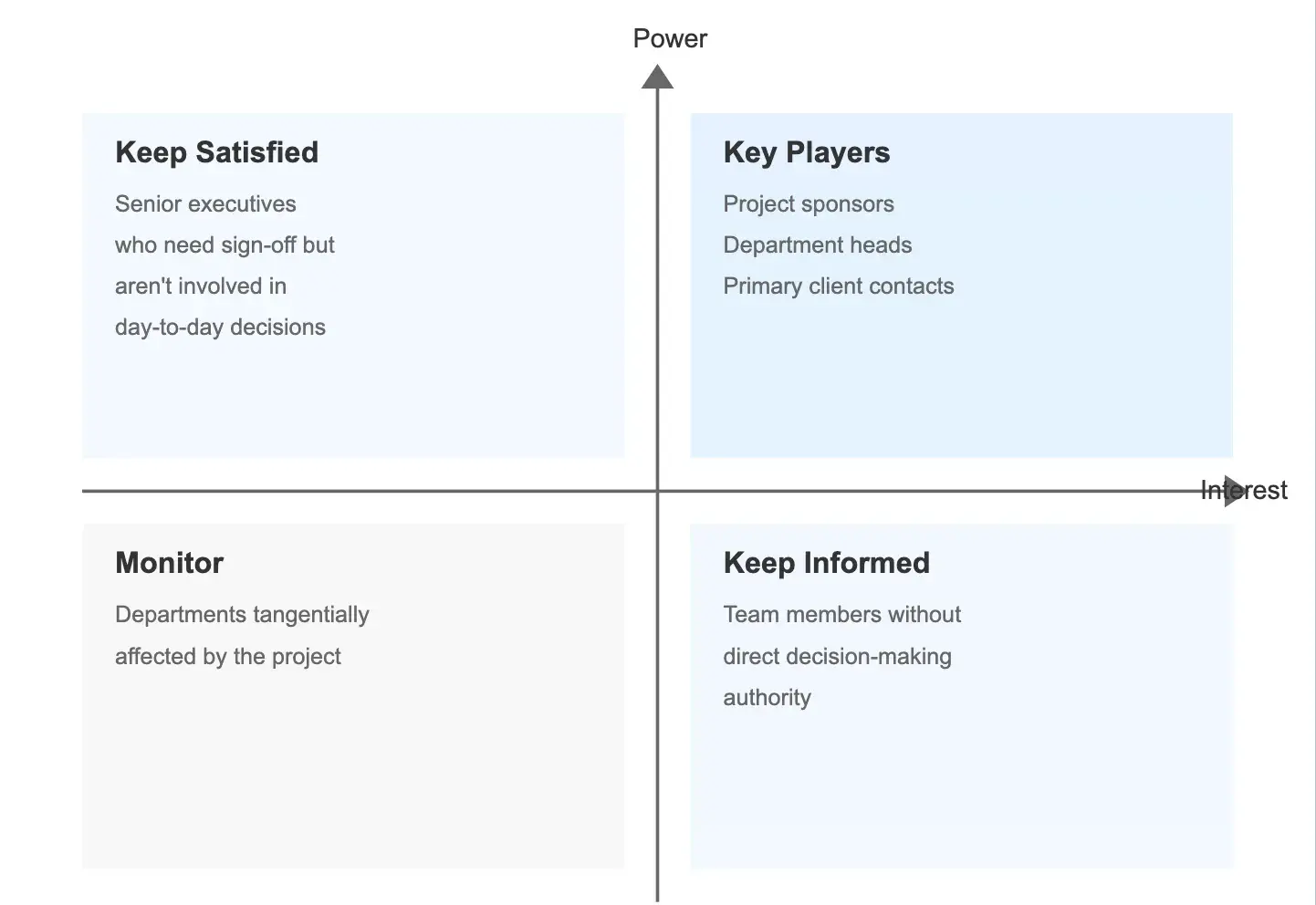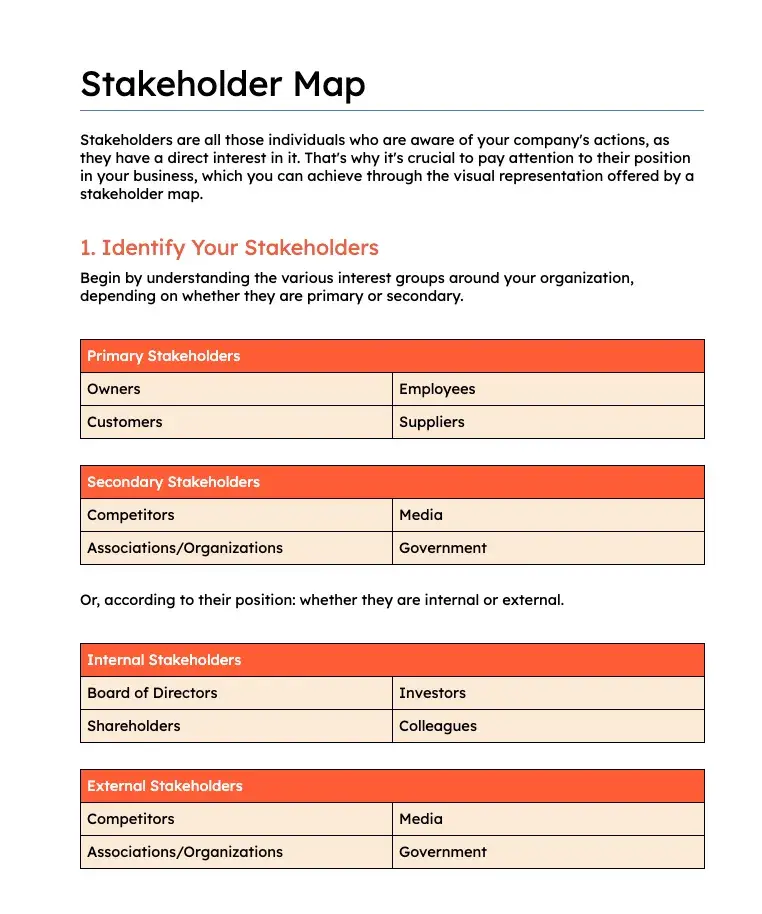How to Create a Stakeholder Map for Seamless Project Tracking
Six years ago, I led a website content overhaul that nearly derailed when the product team and sales department had completely different ideas about our messaging priorities.

Six years ago, I led a website content overhaul that nearly derailed when the product team and sales department had completely different ideas about our messaging priorities. Despite my experience with content strategies, I made a rookie mistake — I hadn’t created a stakeholder map. That experience pushed me to develop a systematic approach to stakeholder management. Now, as a content strategist who’s guided content projects for over 30 SaaS companies, I’ve seen how the right stakeholder strategy can transform scattered feedback into a clear direction. Table of Contents A stakeholder map is a visual document that plots out everyone who has influence over or is affected by your project. It shows who needs to be involved, how much influence they have, and how their priorities connect. What makes it powerful is that it forces you to step back and see the whole picture. You document each stakeholder’s role, their level of influence, what they care about most, and how they prefer to communicate. The map becomes your guide for managing expectations and preventing conflicts before they happen. For example, when I create content strategies for SaaS companies, my stakeholder map typically includes product managers (who know the technical details), sales teams (who talk to customers daily), and executives (who hold the vision) — each bringing different needs to the table. Let me share a real stakeholder map I created for a recent SaaS website revamp project. The map organized the different types of stakeholders into three key circles of influence: Core Decision Makers Key Influencers Supporting Contributors For each person, I noted their primary concerns: This map helped me prioritize feedback and plan my communication strategy. When conflicting opinions arose about messaging priorities, I could refer back to each stakeholder’s core concerns to find common ground. Understanding and identifying your key stakeholders is critical when launching new initiatives or making changes. It ensures smoother implementation and reduces resistance. Here are six steps to create a stakeholder map. Start with a comprehensive brain dump of everyone who might influence or be affected by your project. As Menaka Gopinath, Chief Marketing Officer at Project Management Institute (PMI), explains: “Critical is understanding who is going to be most impacted by the outcome, who is going to guide how you drive the outcome, and who you have to rely on to deliver the outcome. “This helps guide where you can avoid unnecessary barriers — a lot of times, there is a cohort of people who just want to know what’s happening, even if they don’t play a critical role in delivering. Proactive communication at cadenced times can help avoid meddling that can take you off track.” I include obvious stakeholders like direct supervisors and team members. But I also think broader and consider compliance teams who need to review deliverables, external partners who provide resources, and end users who will be impacted by the project outcomes. Create a master list organized by department or function. For each stakeholder, note their role and potential contribution to the project. Look beyond formal titles — sometimes, a junior team member might have crucial institutional knowledge that makes them a key stakeholder. Consider both direct and indirect stakeholders. Direct stakeholders actively participate in the project, while indirect stakeholders feel its effects without direct involvement. For example, your IT team might not attend project meetings, but they’re crucial stakeholders if your project requires technical implementation. Once you’ve identified your stakeholders, evaluate each one based on two key factors: their power (ability to influence the project) and their interest (how much they care about the outcomes). This assessment helps you determine how to manage each relationship effectively. Create a simple grid with power on the vertical axis and interest on the horizontal axis. This visualization helps you place each stakeholder into one of four categories: As Gopinath notes, “At PMI, there is a great deal of learning available to guide stakeholder management. The Stakeholder Salience Framework prioritizes stakeholder engagement based on three attributes — Power, Legitimacy, and Urgency. The more attributes a stakeholder possesses, the greater priority you would put to engaging this stakeholder.” Understanding how each stakeholder prefers to receive information is just as important as knowing what to communicate. Some stakeholders want detailed weekly reports, while others need only high-level monthly updates. Document these preferences in your stakeholder map, noting: Many teams successfully use project management or CRM systems to track and manage these communication preferences systematically. This approach ensures everyone on your team knows how to engage with different stakeholders effectively. According to Iqbal Ahmad, Founder of the Britannia School of Academics, this systematic tracking is crucial: “We make sure that we have a clearly defined Stakeholders Map on our CRM that every member of our management and leadership team can see. This helps us in ensuring that priorities are set accordingly for each and every stakeholder. “Similarly, if we are launching a new project, we make sure to have a specific stakeholder map for that project so that directed and specific project-related efforts can be made to ensure maximum stakeholder engagement.” Preferences might change throughout the project lifecycle. Check in periodically to ensure your communication approach still serves everyone’s needs. Every project operates within a web of internal and external relationships that need careful management. Start by creating two lists of dependencies that could impact your project’s success. As Sidharth Ramsinghaney, Director of Strategy and Operations at Twilio, explains, “Though corporate functions like IT security and finance remain constant, their relative influence and engagement levels shift. Starting with a clean slate for stakeholder mapping, coupled with a robust RACI framework and clear executive sponsorship structure, has proven crucial for project success.” I recommend mapping these relationships in terms of their sequencing — which approvals or inputs need to come first? For example, you might need legal approval before external vendor engagement or customer feedback before internal development can proceed. Remember that dependencies aren’t just about approvals. Consider knowledge dependencies too — who holds crucial information your project needs? Document these information flows to prevent bottlenecks later. Regular feedback from stakeholders shouldn’t feel like pulling teeth. I’ve found creating systematic ways to gather input helps you spot potential issues before they become problems and keeps everyone aligned with your project’s direction. Digital analytics provide a quiet but powerful feedback channel. Track how stakeholders interact with your shared documents, which sections they comment on most, and where confusion typically arises. These patterns reveal more than what people might say in meetings. Set up multiple channels for feedback based on stakeholder preferences. Some might prefer quick voice messages, while others give their best input through collaborative documents. The key is making feedback feel natural rather than forced. Iqbal Ahmad shares, “To gather stakeholder information beyond traditional interviews and surveys, we have implemented innovative techniques tailored to the unique business environment in which we operate. “One effective approach is leveraging data analytics to track real-time behaviors, such as engagement, completion rates, and feedback patterns. Another technique is using sentiment analysis on communication platforms like emails and social media. This provided a clearer understanding of stakeholder concerns and preferences without requiring extensive feedback sessions.” Create regular checkpoints where stakeholders can raise concerns or share wins. But remember — not every stakeholder needs to weigh in on every decision. Be strategic about whose feedback you seek and when. Stakeholder conflicts are inevitable, especially when multiple departments have different priorities for the same project. The key is having a clear system for resolving them before they derail your timeline. I suggest creating a decision matrix that weighs each stakeholder’s input based on their role in the project. When the sales team wants more product features highlighted but the design team pushes for a cleaner layout, you’ll have a framework for prioritizing these competing needs. Document how previous conflicts were successfully resolved. This builds an internal playbook you can reference when similar situations arise. Often, past solutions can be adapted for current challenges. Ahmad explains how a prioritization framework and using other factors helps with this: “We rely on a prioritization framework that evaluates stakeholders beyond the two traditional factors of interest and influence — by attempting to devise tactical solutions that meet the varying and competing expectations of stakeholders across different groups. “For example, when student feedback demanded more flexible learning while our awarding organizations emphasized stricter compliance checks, we prioritized addressing both by designing stricter assessment and quality assurance checks to meet the expectations of both. “Transparency and communication are key to managing such conflicts. We actively involve stakeholders in the resolution process, often through feedback loops or collaborative meetings.” When conflicts arise, I prefer to focus discussions on project objectives rather than individual preferences. I find this shifts conversations from personal opinions to measurable outcomes that benefit the project. Starting with a tested template saves you from building your stakeholder map from scratch — and helps ensure you don’t miss critical relationships that could impact your project’s success. HubSpot offers a stakeholder map template that makes this process simpler. Download HubSpot’s free stakeholder map template now. Use it to: Classify stakeholders, understand their potential contributions or roadblocks, and improve communication with everyone from investors to interest groups involved in your projects. Creating a stakeholder map might seem like extra work when you’re eager to dive into your project. But I’ve learned that this upfront investment pays dividends throughout the project lifecycle. Start small — map out your next content project using the template and guidelines above. Pay attention to how relationships evolve and which communication approaches work best. Your first map won’t be perfect, and that’s okay. Also, stakeholder mapping isn’t a one-time exercise. Let your map grow as you gain new insights about your stakeholders’ needs and priorities.What is a stakeholder map?
Stakeholder Map Example
circle of influence
types of stakeholders
VP of Marketing: Final approval on messaging strategy and budget.
Content Director: Day-to-day decisions on content direction.
Product Marketing Manager: Product positioning and feature communication.
Sales Director: Input on customer pain points and objections.
Product Manager: Technical accuracy and feature roadmap.
Customer Success Lead: User feedback and common customer questions.
SEO Specialist: Keyword strategy and content optimization.
Brand Designer: Visual consistency and brand guidelines.
Legal Team: Compliance review and risk assessment.
How to Create a Stakeholder Map
1. Identify and list all potential stakeholders.
2. Assess power and interest levels.

3. Define communication preferences and needs.
4. Plot internal vs. external dependencies.
Internal Dependencies
External Dependencies
Legal team for compliance review
Finance for budget approval
IT for technical implementation
Product team for technical accuracy
Brand team for visual consistency
Clients or customers
Regulatory bodies
Vendors or contractors
Industry partners
External subject matter experts
5. Build feedback loops.
6. Plan for conflict resolution.
Stakeholder Map Template
Start Building Your Stakeholder Strategy

 Hollif
Hollif 

































